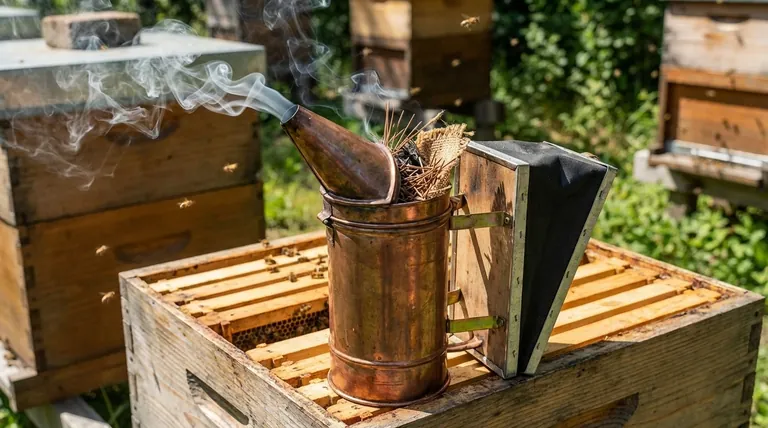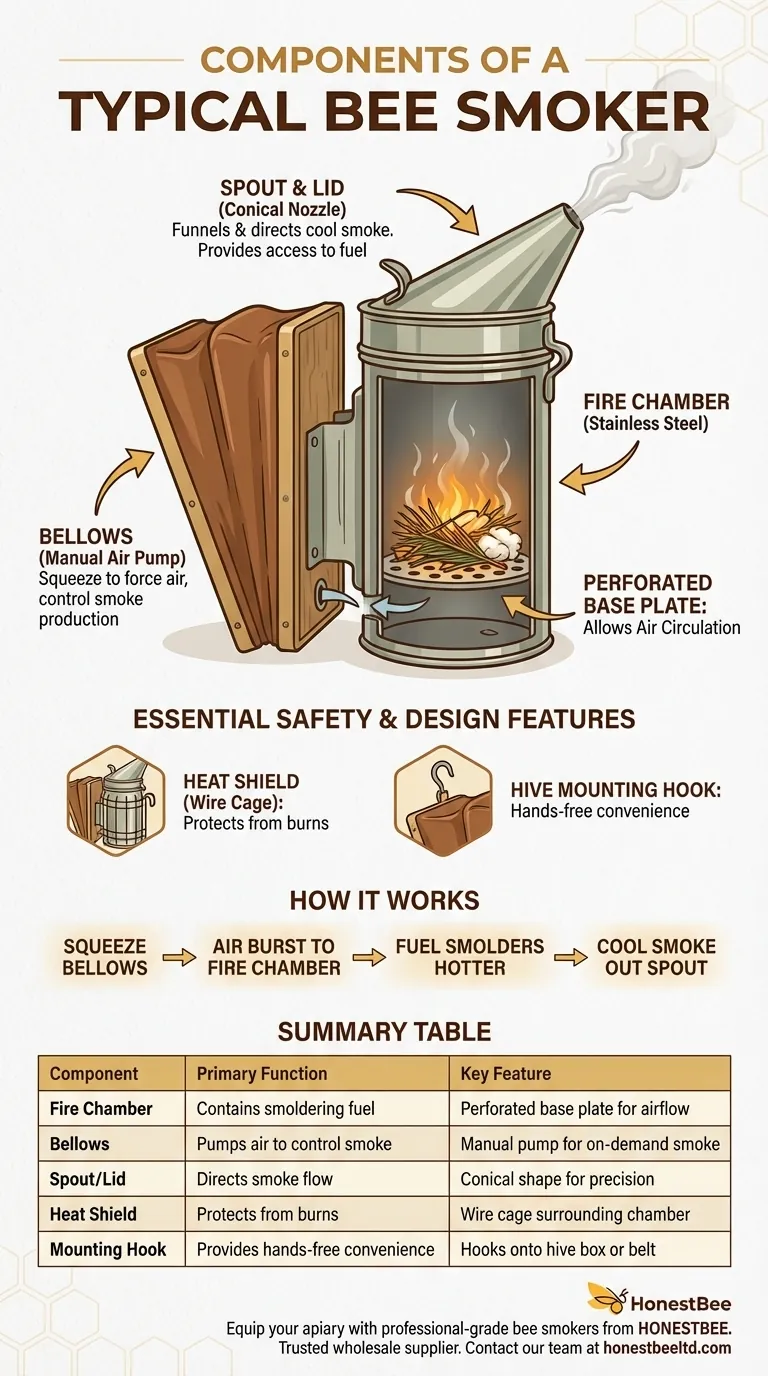At its core, a bee smoker is a simple yet indispensable tool comprised of three main components. These are the fire chamber (a metal can for holding fuel), the bellows (an attached air pump), and a spout (a conical lid to direct the smoke). Together, they allow a beekeeper to create a controlled puff of cool smoke to calm bees during hive inspections.
The genius of the bee smoker lies in its simple design. It's not just a fire pot; it's a precisely engineered system where a manual air pump (the bellows) gives you complete control over a low-oxygen, smoldering fire to produce cool, gentle smoke on demand.

How a Bee Smoker Works: The Core Components
A bee smoker's effectiveness comes from the elegant interaction between its three primary parts. Understanding each one's role clarifies how this simple device is so crucial for beekeeping.
The Fire Chamber: The Heart of the Smoker
The fire chamber, or firebox, is the main cylindrical body of the smoker. Its primary job is to safely contain the smoldering fuel.
It is typically made of stainless steel for durability and heat resistance. Inside, you will often find a perforated base plate or inner grid. This small platform holds the fuel up off the bottom, allowing air from the bellows to circulate underneath for more efficient smoldering.
The Bellows: The Lungs of the Smoker
The bellows are the flexible, pump-like component attached to the side of the fire chamber. Their function is to provide a controlled supply of oxygen to the fire.
When you squeeze the bellows, they force a jet of air through a small opening at the base of the fire chamber. This burst of oxygen causes the fuel to momentarily burn hotter, producing the thick, cool smoke that is then pushed out the top. This mechanism is what gives the beekeeper control over the amount and timing of the smoke.
The Spout and Lid: Directing the Flow
The top of the smoker is a removable lid that tapers into a nozzle or spout. This has two critical functions.
First, the conical shape funnels the smoke into a focused stream, allowing the beekeeper to direct it precisely where it's needed, such as into the hive entrance or under the inner cover. Second, the lid provides access to the fire chamber for adding or adjusting fuel.
Essential Safety and Design Features
Beyond the three core components, quality smokers include features designed for beekeeper safety and convenience during use.
The Heat Shield or Cage
Most smokers are surrounded by a wire frame or heat shield. This is a critical safety feature that creates a protective barrier around the hot fire chamber, significantly reducing the risk of accidental burns to the beekeeper.
The Hive Mounting Hook
A small hook is often attached to the smoker, usually near the bellows. This simple addition is incredibly useful, allowing the beekeeper to hang the hot smoker on the side of a hive box or a tool belt, keeping it within reach without having to place it on the ground.
Quality of Materials
The choice of materials directly impacts the tool's lifespan. Look for welded stainless steel construction, as this is more durable than riveted designs. A well-built smoker will withstand the high heat and repeated use of a busy apiary.
Common Pitfalls to Avoid
While the design is simple, user error can lead to poor performance or unsafe conditions.
Choosing the Wrong Fuel
The smoker itself is only half the equation. Using inappropriate fuel can produce hot, acrid smoke that agitates bees or is toxic. Always use natural, untreated materials like pine needles, cotton fibers, or untreated burlap.
Over-Pumping the Bellows
Continuously pumping the bellows can cause the fire to become too hot, creating embers or even flames instead of cool smoke. Use short, deliberate puffs only when smoke is needed to keep the fire smoldering, not roaring.
Neglecting Airflow
For a smoker to work correctly, the air must flow freely. Ensure the grate at the bottom of the fire chamber and the air inlet from the bellows do not become clogged with ash or residue, as this will stifle the fire.
Making the Right Choice for Your Goal
Selecting a smoker depends on your specific needs as a beekeeper.
- If your primary focus is safety and hobbyist use: Choose a smoker with a full, wrap-around heat shield and a stable base to prevent it from tipping over.
- If your primary focus is longevity for frequent inspections: Invest in a model with high-quality, welded stainless steel construction and durable leather bellows.
- If your primary focus is convenience in the bee yard: Look for a smoker with a well-placed mounting hook and a lid that is easy to open and close while wearing gloves.
Ultimately, understanding these core components empowers you to use this essential tool safely and effectively to manage your hives.
Summary Table:
| Component | Primary Function | Key Feature |
|---|---|---|
| Fire Chamber | Contains smoldering fuel | Perforated base plate for airflow |
| Bellows | Pumps air to control smoke | Manual pump for on-demand smoke |
| Spout/Lid | Directs smoke flow | Conical shape for precision |
| Heat Shield | Protects from burns | Wire cage surrounding the chamber |
| Mounting Hook | Provides hands-free convenience | Hooks onto hive box or belt |
Equip your apiary with professional-grade bee smokers from HONESTBEE.
As a trusted wholesale supplier for commercial apiaries and equipment distributors, we provide durable, high-performance beekeeping supplies built to withstand the demands of frequent hive inspections. Our smokers feature welded stainless steel construction and essential safety designs to ensure longevity and beekeeper safety.
Ready to improve your hive management efficiency? Contact our team today to discuss your wholesale needs and discover how our equipment can support your operation's success.
Visual Guide

Related Products
- Premium Traditional Copper Bee Smoker with Bellows
- Stainless Steel Honey Bee Smoker Hive and Honeycomb Smoker for Beekeeping
- European Stainless Steel Bee Smoker for Honey Bee Hive
- Stainless Steel Electric Beehive Smoker for Beekeeping and Bee Keeper Use
- Electric Bee Smoker European Style Bee Hive Smoker for Beekeeping
People Also Ask
- How does water mist work as an alternative to smoke in beehives? A Guide to Safe & Effective Use
- What are the main components of a bee smoker? A Guide to Safe and Effective Hive Management
- What are the benefits of using smoke properly in beekeeping? Achieve Calm, Safe Hive Inspections
- How did early beekeepers use bee smokers? Master Ancient Bee Calming Techniques
- What are the main parts of a bee smoker? Essential Components for Calm Hive Management



















